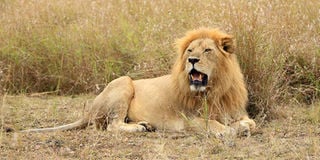Kenya has fewer lions than previously estimated

A lion in a national reserve.
What you need to know:
- Kenya’s national population of lions was previously estimated at 2,749 in 2002 and 2,280 in 2004. While more recently in 2007 the lion population was estimated at 1,970.
- KWS Director-General John Waweru said that the scientific survey will guide efforts to conserve the species.
There are far much less lions in the country than has been publicised by conservationists and the Kenya Wildlife Service (KWS), a new scientific study is now unravelling.
Carnivore scientists, including some from the KWS, said Thursday that preliminary results coming out of an ongoing national survey of lions have indicated that there are about less than half the figures previously indicated in some of the lion-range lands.
“We do not yet have a total national survey so far except for the different areas for which we’ve completed the surveys. But the previous numbers that have been given by KWS were a little overestimated,” said Mr Shadrack Ngene, the KWS head of species conservation and management, during the annual carnivore conference where preliminary results for some of the regions were released.
“These current figures should be considered as the baseline rather than try to compare them with the previous numbers we’ve always given, because the method is totally different from the ones that have been used previously to estimate the numbers,” he added.
Scientists described these old figures as “ … little more than guesses.”
CENSUS
The ongoing lion census is the first ever scientific census on the population and geographical range of the lion, an endangered predator in Kenya.
The lion, in spite of being one of the big five and a flagship species of Kenya for tourism and conservation research, has never been counted.
Kenya’s national population of lions was previously estimated at 2,749 in 2002 and 2,280 in 2004. While more recently in 2007 the lion population was estimated at 1,970.
Regionally, according to earlier estimates done in 2007, 825 lions were found in Maasai land, 675 in Tsavo, 230 in Laikipia, 40 in Meru, 100 in Samburu-Isiolo, 38 in Ngorongoro crater and 26 in Nairobi National Park, and 100 in Northern Kenya.
But the current survey - which involves individual counts of all lions above one year - estimates that there are 484 lions in Maasai land, 179 in Amboseli, 22 in Soralo (South Rift Association of Land Owners), 41 in Nairobi National Park and its ecosystem and 432 in the Tsavo ecosystem .
Surveys in the Samburu-Isiolo, Meru, Laikipia and Northern Kenya ecosystems are still ongoing.
METHODOLOGY
It is estimated that the national survey will be concluded by June next year.
The previously used methods included use of paws and tracks that the scientists now say may have given not-so accurate appraisals.
The scientific surveys involve call-in and track surveys, pictures and facial identification of each individual lion using their unique identifiable feature — the whisker spots, which are found on each side of the face in rows, as well as other unique characteristics.
“This time round we are engaging a new more meticulous methodology based on contemporary science to count the lions,” Dr Arjun Gopalaswamy, a statistical ecologist who has developed a survey model for large carnivores that has been used in Asian countries to count tigers.
CONSERVATION
KWS Director-General John Waweru said the importance of the count has in recent times gained momentum within conservation circles in the face of increased wildlife conservation challenges.
Mr Waweru noted that the scientific survey will guide efforts to conserve the species.
“We are keen to apply scientific research and adopt international best practices to promote conservation of carnivores,” Mr Waweru said.
Mr Nicholas Elliot, a large carnivore ecologist, who is working with KWS on the census, commended Kenya, saying, “Kenya is the first country to do an actual national count of lions.”




